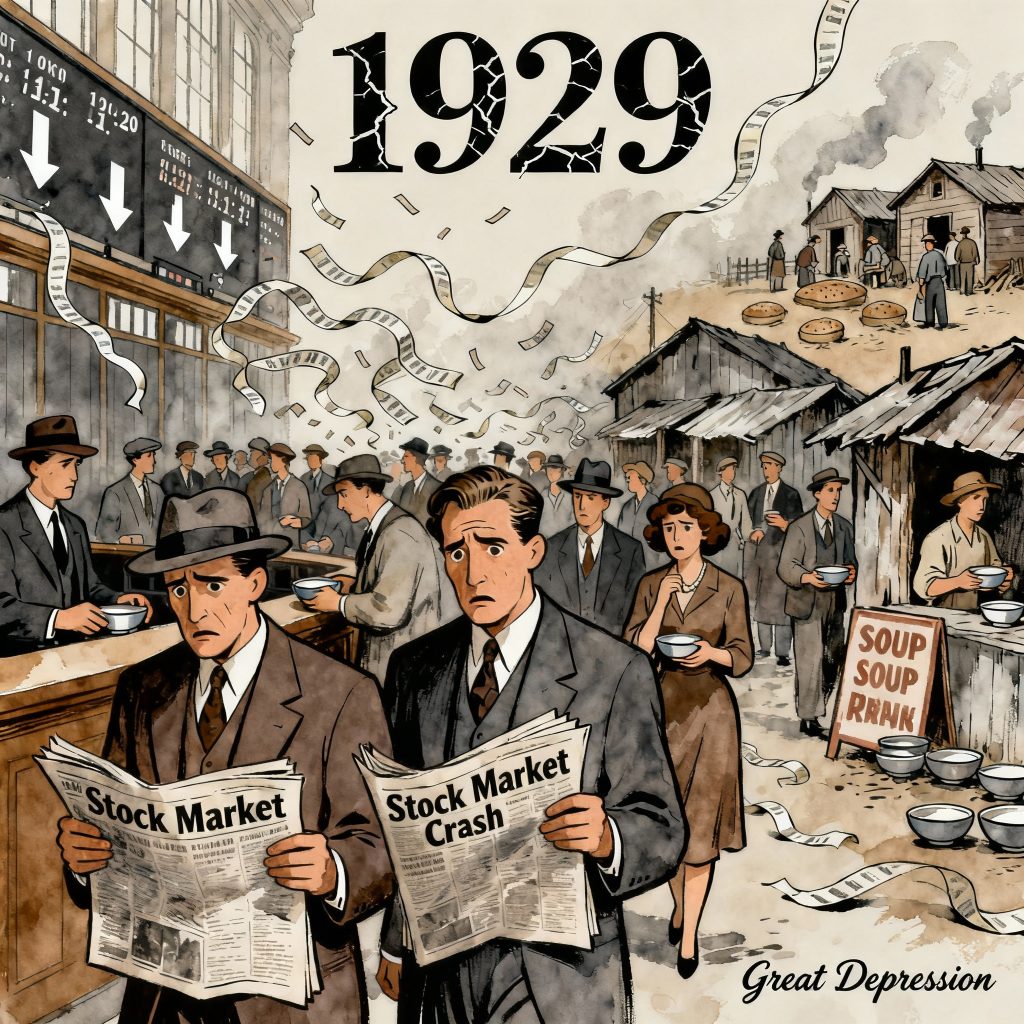Have you ever wondered when was the Great Depression and why it still matters nearly a century later? For young professionals, entrepreneurs, or anyone interested in personal finance, the Great Depression is more than just a history lesson—it’s a blueprint of what can happen when economies collapse. It started in 1929 and lasted through much of the 1930s, changing the global economy, politics, and personal wealth forever.
In this article, we’ll take a deep dive into when the Great Depression began, what caused it, how it shaped business and finance, and what lessons we can apply to today’s economy. By the end, you’ll have a clear and practical understanding of why this historic downturn still influences our financial world.
Overview: When Did the Great Depression Start?
The Great Depression began in 1929, following the infamous stock market crash on October 29, 1929, also known as Black Tuesday. While it officially lasted until the late 1930s in the United States, many parts of the world felt its effects well into the early 1940s.
Key points to remember:
-
Originated in the United States but spread globally.
-
Stock market crash triggered the downturn.
-
Peak unemployment in the U.S. reached 25%.
-
Thousands of banks collapsed, wiping out savings.
Causes of the Great Depression
Understanding causes can help modern entrepreneurs and professionals avoid repeating history.
1. Stock Market Crash of 1929
Speculation ran wild in the 1920s. People borrowed heavily to buy stocks. When prices crashed, investors couldn’t repay loans, sparking panic.
2. Bank Failures
Over 9,000 banks failed. Unlike today’s FDIC-insured accounts, people lost everything.
3. Decline in Consumer Spending
With no jobs and disappearing savings, families cut back on expenses. This meant businesses earned less, leading more to close down.
4. Dust Bowl & Agricultural Collapse
Severe droughts in the American plains worsened unemployment and poverty, forcing families to migrate in search of work.
5. Global Trade Collapse
U.S. tariffs (like the Smoot-Hawley Tariff) led to retaliation by other countries, stifling international trade.
Impact of the Great Depression
The Great Depression wasn’t just about money—it reshaped lifestyles, businesses, and global power.
For Everyday People
-
Jobs vanished, and many relied on soup kitchens.
-
Families lost homes and savings.
-
Confidence in financial institutions collapsed.
For Businesses
-
Small businesses shut down overnight.
-
Big corporations consolidated power.
-
Global supply chains crumbled, a reminder of today’s risks.
For Governments
-
Led to the rise of social welfare programs in the United States.
-
Paved the way for major political changes globally, including the rise of authoritarian regimes in Europe.
Lessons from the Great Depression for Today
Even though the Great Depression happened nearly 100 years ago, young adults and entrepreneurs can still learn financial wisdom from it.
-
Diversify Investments – Don’t put all your money in stocks. Spread across real estate, bonds, or even index funds.
-
Emergency Funds Matter – A 6-12 month savings buffer can protect against job loss.
-
Debt Caution – Avoid overleveraging like investors did in the 1920s.
-
Government Intervention Can Help – Economic policies like stimulus packages can soften downturns.
-
Innovation Thrives in Crisis – Tech startups and digital platforms often grow faster in recessions.
Current Relevance: Could a Depression Happen Again?
While today’s financial systems are stronger, recession fears and inflation pressures often make experts revisit the Great Depression for comparison. For example, during the COVID-19 pandemic (2020), governments took swift action with stimulus checks and relief funds to prevent another depression.
Trends today show:
-
Startups and remote work booming despite global economic challenges.
-
Digital finance (like crypto and fintech) providing alternative security.
-
Entrepreneurs learning to survive downturns with leaner business models.
Tips for Young Professionals & Entrepreneurs
-
Track your spending and investments regularly.
-
Build businesses on sustainable, recession-proof models.
-
Stay updated on global economic shifts (inflation, trade policies, tech adoption).
-
Learn from the past: what destroyed wealth in 1929 can inform smarter strategies today.
Frequently Asked Questions
1. When was the Great Depression?
It began in 1929 with the stock market crash and lasted throughout the 1930s, with ripple effects globally until the early 1940s.
2. What caused the Great Depression?
Main causes include the 1929 stock market crash, bank failures, reduced consumer spending, agricultural decline, and global trade collapse.
3. How did the Great Depression affect people?
Millions lost jobs, homes, and savings. Poverty skyrocketed, and governments had to step in with welfare support.
4. Could another Great Depression happen today?
While not likely due to stronger regulations, severe recessions are still possible if global trade breaks down or financial systems fail.
5. What lessons can professionals learn from the Great Depression?
Diversify investments, maintain an emergency fund, avoid unnecessary debt, and focus on sustainable business strategies.
Final Thoughts
The answer to when was the Great Depression may seem simple—1929—but its lessons run far deeper. For young professionals and entrepreneurs, it serves as a roadmap for understanding risks, managing finances, and preparing for future uncertainties. History doesn’t just repeat—it teaches.
If you’re serious about financial growth, keep learning from past downturns and investing smarter for the future.
Take action today: Review your finances, start diversifying, and build resilience before the next economic storm hits.










